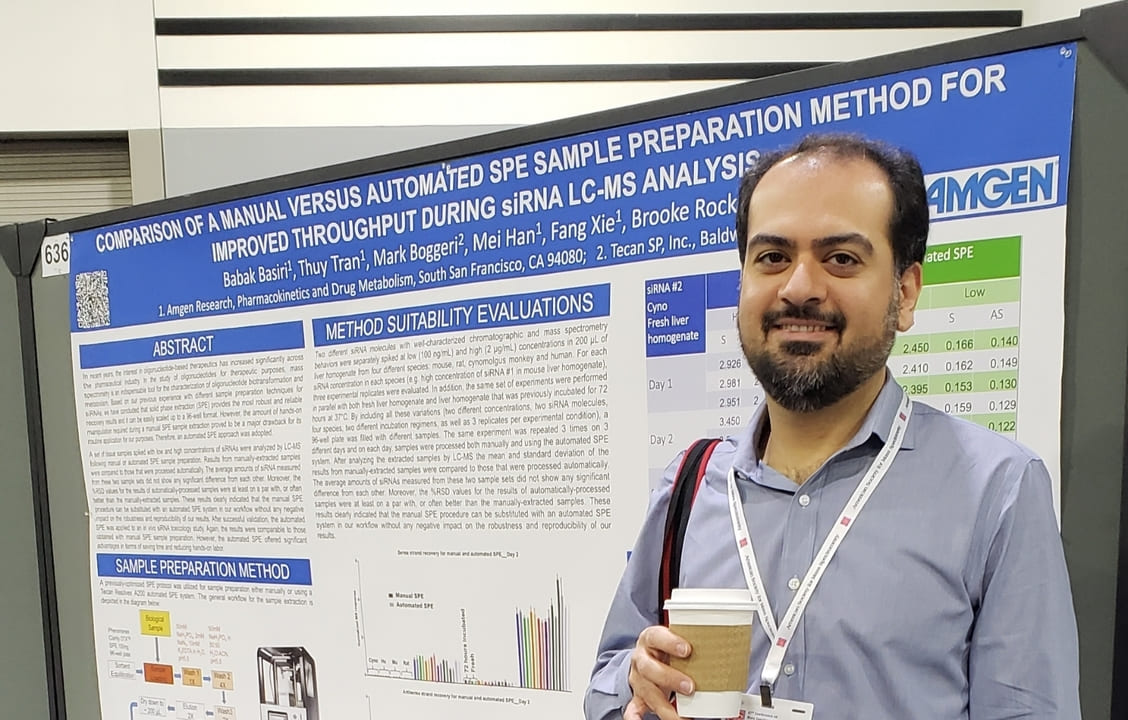Developing drugs that are effective, with minimal side effects, is important to improve the lives of patients suffering from serious diseases. Leading biotechnology company Amgen focuses on producing therapies for a wide range of conditions, and is currently developing small interfering RNAs (siRNAs) as a method to treat patients with a genetic predisposition to heart disease.
Determining the distribution and breakdown of drugs after they enter the body is vital to understand a drug’s mechanism of action (MOA), any possible side effects it causes and the effect of any metabolites. The Pharmacokinetics and Drug Metabolism (PKDM) department at Amgen studies the distribution of drugs in the body, as Babak Basiri, a scientist in the team, explained: “Our group looks at how various classes of drugs affect animal models. My focus is on the distribution and MOA of siRNAs – double-stranded oligonucleotides that can be used to
‘interfere’ with the production of targeted proteins. They achieve this by binding to, and promoting the degradation of, specific messenger RNAs (mRNAs), preventing the translation of the associated protein. We produce a number of synthetic siRNAs that we are testing to stop the expression of certain ‘bad’ gene mutations, for instance, one that targets patients with a defective lipoprotein(a) gene.”
Lp(a) is synthesized in the liver, and is comprised of an LDL-like particle with an apolipoprotein(a) coiled around it. Babak continued: “High levels of Lp(a) have been identified as an independent risk factor in cardiovascular disease, yet it is largely unknown how this particle contributes to disease. Over one billion families globally are at risk or living with heart disease due to high Lp(a) and, of these cases, around 20 percent are due to a genetic mutation. Patients with elevated levels may have a two- to fourfold increased risk of heart attacks and other serious events, and our aim is to develop siRNAs that limit the production of this protein, reducing the risk of heart disease.”
“I mainly study plasma samples to analyze overall drug concentration, and liver samples to see if the siRNAs have made it to the target location. The problem with these liver homogenate samples is that they cannot be directly injected into the mass spectrometer, and we need to use solid phase extraction (SPE) to clean up the sample and concentrate the siRNA to a level suitable for analysis. There are a number of different molecules in our sample that we need to wash away – including hemoglobin, other proteins and fat – as they could interfere with our measurements.”
 Babak presenting a poster on the use of the Resolvex A200 for automated SPE sample preparation at ASMS
Babak presenting a poster on the use of the Resolvex A200 for automated SPE sample preparation at ASMS
“We use positively-charged SPE cartridges that the negatively-charged siRNA can bind to, and use at least six different solvents and wash buffers before we elute the final product. Previously, we were performing the entire process manually and it was very laborious. We were simply waiting to add buffers at the correct time and, with the growing numbers of samples we were studying, it was becoming impossible to do by hand, as our maximum throughput was about two 96-well plates a day. We trialed a Resolvex® A200 system, which Tecan installed in our lab and helped us to set up. The platform allows us to automate the entire SPE process; I can simply hook up all of my different solvents, program it to perform the washes I need – selecting the buffer, the volume required and the order of the washes –and load my samples. I can then walk away and return a couple of hours later to my samples that are ready to analyze via mass spec straightaway.”
 Babak and his team enjoying a group lunch
Babak and his team enjoying a group lunch
“Over the course of our trial with the Resolvex A200, we ran a lot of samples and different experiments, such as stability studies or looking at metabolism profiles. Comparing the results to previous manually-generated results, we were happy with every experiment we ran; the data was more robust, with less variation and better consistency, and so we invested in our own system. Although there were other instruments out there with more ‘bells and whistles’, the A200 is perfect for our workflow. Its flexibility accommodates our varying workload, processing anything from a few to hundreds of samples a day. It’s also easy to use and doesn’t require any specialized programming, which is important in our busy lab, as multiple people from different projects are using the system. An added bonus is that it doesn’t take up any more space than the manual unit we had previously.”
Overall, the system is very intuitive and user friendly, and has increased our throughput dramatically to double or triple what we were performing before. It’s not just the extra throughput that is amazing, but the time we are saving is huge.
“Overall, the system is very intuitive and user friendly, and has increased our throughput dramatically to double or triple what we were performing before. It’s not just the extra throughput that is amazing, but the time we are saving is huge. The ability to just set the system running is a godsend, as it frees our hands for other work or data analysis, and that alone is phenomenal,” concluded Babak.
To find out more about Tecan’s SPE solutions, visit www.tecan.com/ppspe
To learn more about Amgen, go to www.amgen.com
Keywords:









